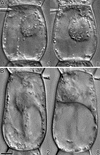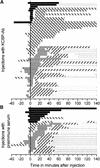The kinesin-like calmodulin binding protein is differentially involved in cell division
- PMID: 10852941
- PMCID: PMC149097
- DOI: 10.1105/tpc.12.6.979
The kinesin-like calmodulin binding protein is differentially involved in cell division
Abstract
The kinesin-like calmodulin (CaM) binding protein (KCBP), a minus end-directed microtubule motor protein unique to plants, has been implicated in cell division. KCBP is negatively regulated by Ca(2)+ and CaM, and antibodies raised against the CaM binding region inhibit CaM binding to KCBP in vitro; therefore, these antibodies can be used to activate KCBP constitutively. Injection of these antibodies into Tradescantia virginiana stamen hair cells during late prophase induces breakdown of the nuclear envelope within 2 to 10 min and leads the cell into prometaphase. However, mitosis is arrested, and the cell does not progress into anaphase. Injection of antibodies later during cell division has no effect on anaphase transition but causes aberrant phragmoplast formation and delays the completion of cytokinesis by approximately 15 min. These effects are achieved without any apparent degradation of the microtubule cytoskeleton. We propose that during nuclear envelope breakdown and anaphase, activated KCBP promotes the formation of a converging bipolar spindle by sliding and bundling microtubules. During metaphase and telophase, we suggest that its activity is downregulated.
Figures







Comment in
-
Cytokinesis: the art of partitioning.Plant Cell. 2000 Jun;12(6):827-8. doi: 10.1105/tpc.12.6.827. Plant Cell. 2000. PMID: 10970140 Free PMC article. No abstract available.
Similar articles
-
Roles for kinesin and myosin during cytokinesis.Philos Trans R Soc Lond B Biol Sci. 2002 Jun 29;357(1422):761-6. doi: 10.1098/rstb.2002.1093. Philos Trans R Soc Lond B Biol Sci. 2002. PMID: 12079671 Free PMC article. Review.
-
Bundling of microtubules by motor and tail domains of a kinesin-like calmodulin-binding protein from Arabidopsis: regulation by Ca(2+)/Calmodulin.Biochem Biophys Res Commun. 2000 Jan 7;267(1):201-7. doi: 10.1006/bbrc.1999.1896. Biochem Biophys Res Commun. 2000. PMID: 10623599
-
Minus end-directed kinesin-like motor protein, Kcbp, localizes to anaphase spindle poles in Haemanthus endosperm.Cell Motil Cytoskeleton. 1998;41(3):271-80. doi: 10.1002/(SICI)1097-0169(1998)41:3<271::AID-CM8>3.0.CO;2-W. Cell Motil Cytoskeleton. 1998. PMID: 9829781
-
Localization of a kinesin-like calmodulin-binding protein in dividing cells of Arabidopsis and tobacco.Plant J. 1997 Dec;12(6):1429-37. doi: 10.1046/j.1365-313x.1997.12061429.x. Plant J. 1997. PMID: 9450347
-
Plant Kinesin-12: Localization Heterogeneity and Functional Implications.Int J Mol Sci. 2019 Aug 28;20(17):4213. doi: 10.3390/ijms20174213. Int J Mol Sci. 2019. PMID: 31466291 Free PMC article. Review.
Cited by
-
Polarized cell growth, organelle motility, and cytoskeletal organization in conifer pollen tube tips are regulated by KCBP, the calmodulin-binding kinesin.Planta. 2013 Sep;238(3):587-97. doi: 10.1007/s00425-013-1919-8. Epub 2013 Jun 20. Planta. 2013. PMID: 23784715
-
Kinesins in the Arabidopsis genome: a comparative analysis among eukaryotes.BMC Genomics. 2001;2:2. doi: 10.1186/1471-2164-2-2. Epub 2001 Jun 25. BMC Genomics. 2001. PMID: 11472632 Free PMC article.
-
Localization of two homologous Arabidopsis kinesin-related proteins in the phragmoplast.Planta. 2004 Nov;220(1):156-64. doi: 10.1007/s00425-004-1324-4. Epub 2004 Jul 16. Planta. 2004. PMID: 15258761
-
The Cytoskeleton and Its Regulation by Calcium and Protons.Plant Physiol. 2016 Jan;170(1):3-22. doi: 10.1104/pp.15.01506. Plant Physiol. 2016. PMID: 26722019 Free PMC article. Review.
-
Roles for kinesin and myosin during cytokinesis.Philos Trans R Soc Lond B Biol Sci. 2002 Jun 29;357(1422):761-6. doi: 10.1098/rstb.2002.1093. Philos Trans R Soc Lond B Biol Sci. 2002. PMID: 12079671 Free PMC article. Review.
References
-
- Asada, T., and Collings, D. (1997). Molecular motors in higher plants. Trends Plant Sci. 2, 29–37.
-
- Asada, T., and Shibaoka, H. (1994). Isolation of polypeptides with microtubule-translocating activity from phragmoplasts of tobacco BY-2 cells. J. Cell Sci. 107, 2249–2257. - PubMed
-
- Asada, T., Kuriyama, R., and Shibaoka, H. (1997). TKRP125, a kinesin-related protein involved in the centrosome-independent organization of the cytokinetic apparatus in tobacco BY-2 cells. J. Cell Sci. 110, 179–189. - PubMed
-
- Bowser, J., and Reddy, A.S.N. (1997). Localization of a kinesin-like calmodulin-binding protein in dividing cells of Arabidopsis and tobacco. Plant J. 12, 1429–1437. - PubMed
Publication types
MeSH terms
Substances
LinkOut - more resources
Full Text Sources
Miscellaneous

